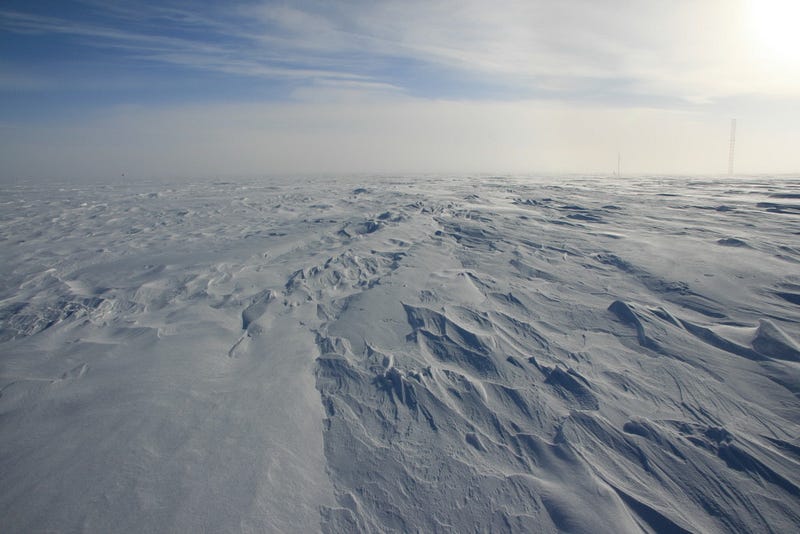Growth in Isolation
Western instructor Eli Loomis’ journey to Antarctica’s South Pole
STORY BY STUART KRUIDENIER | PHOTOS BY DANIELLA BECCARIA
Imagine living for four months in a desolate place, uninhabitable to most basic forms of life.
Each breath brings in the wryness of the air around and 24-hours of light makes sleeping a chore.
Welcome to Antarctica’s South Pole.
Temperatures average somewhere around -57.1 degrees Fahrenheit and 99 percent of it is covered with ice, making it the driest place on the planet.
“It’s like that scene in the Matrix where everything is white. Everything around you is flat, white, and dead”.
Western instructor Eli Loomis spent nearly half a year at the Amundsen-Scott South Pole station growing vegetables for NASA in their South Pole Growth Chamber (SPGC). The majority of his work focused on the study and development of a sustainable food-growth method for a future mission to Mars.
The idea of growing vegetables in a location that is as void of life as the South Pole sounds absurd, which is what makes it an ideal location for such a project.
The Pole’s climate, temperatures, isolation and terrain make for an environment that reflects the conditions that in some ways can mirror the experience of outer space.
Loomis understood that a future Mars assignment would require biologists that could rock-climb in order to repel into canyons and look for evidence of life.
This project was a conceivable means of working his way towards being part of such an undertaking.
After completing a graduate degree with Western’s Biology program in 2008, Loomis, 28 at the time, was looking for an adventure.
He had been to Antarctica twice before, in 2003 and 2004, to study Algae growth patterns.
During these two trips, he stayed at a research center at the Antarctic Peninsula on Anvers Island.
Loomis thrived in this environment, enjoying the mountainous terrain surrounded by water and beautiful sightlines. These experiences created a positive image of Antarctica for Loomis, one that was much different than what he would experience at the Pole.
In February of 2010, Loomis boarded a plane headed to Antarctica for the third and quite possibly final time.
He arrived several hours later to the South Pole’s Amundsen Station. An impressive result of modern engineering, the Station stands upon 12-foot stilts that are constructed so that snow blows under the structure rather than accumulating around it.

“It feels like you’re on a giant ship in the middle of nowhere,” Loomis says.
Full of metal staircases and long unadorned hallways, it resembles what one might see in a futuristic film from the ’90s. It is the home to a number of different scientific projects ranging from earthquake studies to space physics.
While there were hundreds of other workers at the station, Loomis was the only person involved with the vegetable project. The process he specialized in was a hydroponic growth method, meaning no soil or sunlight is necessary to sustain plant life.
This practice is valuable to study in the context of outer space, given the absence of sunlight or soil aboard a space shuttle.
Put simply, this process means hydroponic fluid is pumped to the top of the plant’s trays and is then trickled to the bottom and out the end.
The system also consists of 13 overhead sodium vapor lamps, which are used to provide artificial lighting.

Loomis was in charge of overseeing the growth of a wide range of vegetables in the SPGC such as leafy greens and cucumbers.
The structure as a whole was controlled by a computer system that Loomis was responsible for troubleshooting.
Plants would occasionally overflow with fluid and clog their circulation tubes, but the system was fairly easy to maintain, he says.
While the plant-growing operation itself was successful, life at the South Pole became testing for Loomis.
It may be safe to say that such an environment would likely be difficult for anyone, but Loomis believes that his deep connection with nature made those four months even more trying for him.
Senses that we take for granted like the smell of plants and feeling of moisture in the air are few and far between at the South Pole. Being without living things can, and will, take its toll on an otherwise grounded person.
Sure most difficult situations get better with time, but Loomis says that he did not see a way out of this one while remaining in the Pole.
“People definitely act crazy,” he says. “Not Hollywood crazy, but when you’re in a situation like that it’s easy to get a little twitchy.”
So, what was the main takeaway from this trip outside of the successful plant growth?
“I found out that I definitely don’t want to go to Mars,” he says. “I decided I want to stay here, where I can smell plants.”
As the project finally came to an end, Loomis and others took a flight out of the Pole, which took them to Christ Church, New Zealand.
Upon exiting the plane, the stark contrast was noticeable.
The cold, dry climate was no more, and had been replaced by a vibrant ecosystem.
The familiar smell of plants and wildlife overwhelmed Loomis, as he began to cry tears of joy.
